The Grid Compass, the first clamshell-case laptop computer
How do you tell if a new technology product is a brilliant breakthrough?
Listening to its creators doesn’t work: Tech companies have an annoying tendency to promote everything as a brilliant breakthrough. And tech journalists have a history of getting irrationally exuberant over stuff that doesn’t end up amounting to much.
Real breakthroughs aren’t always immediately identifiable as breakthroughs. Sometimes, they just go on to change the world without anyone knowing it’s going to happen or even talking about it much. Their influence becomes so pervasive that people think of it as unremarkable, not remarkable.
Take, for instance, Grid Systems’ Grid Compass 1101, a portable computer which was announced in April, 1982. It wasn’t the first computer designed to be toted. It was just the first one in a briefcase-shaped case with a screen on one half of the interior, a keyboard on the other and a hinge in the middle. It was, in other words, the first computer with a clamshell case–or, to use a more common term, the first laptop.
(PHOTOS: 14 Masterpieces of Gadget Design)
The Compass was innovative in multiple ways, and certainly got a fair amount of attention in its day. Fortune, for instance, named it as one of the magazine’s products of the year for 1982. It even went up on the Space Shuttle, a rare achievement for any commercial product.
As far as I know, however, nobody was smart enough to declare that its basic design would come to dominate the PC business. (Which it did, although it took a couple of decades before laptops outsold desktops for the first time.) The name “Compass” was downright prescient: The machine did indeed point the entire industry in the direction it would follow for the next few decades.
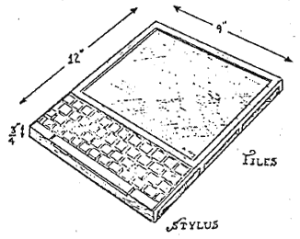
Wikipedia
Almost all portable PCs have had clamshell cases for so long that it’s tempting to assume that it was obvious from the start that it was the ideal form factor. Not so. In 1968, visionary technologist Alan Kay had proposed a sleek portable computing tablet for kids, the Dynabook, in 1968. It went on to be wildly influential. But when he drew it, he depicted a tablet-like device with a screen and keyboard, but no hinge.
With the Dynabook, Kay’s mind raced far ahead of what the technology of the time was capable of creating. Portable computers didn’t really exist in 1968, unless you want to count a case that let you transport a 75-pound Teletype machine. Even in 1975, IBM’s first “portable computer” weighed 55 pounds.
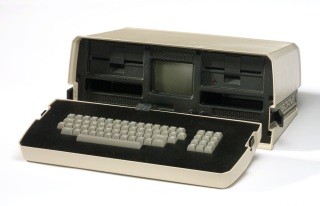
Getty Images
By 1979, which is when Grid began design work on the Compass, the notion of designing a portable computing device that was truly portable wasn’t completely nutty. But it also wasn’t a cakewalk. While the company was busy with research and development, it was beaten to market by Adam Osborne’s Osborne 1, which went on to become the first successful portable computer.
The Osborne wasn’t a clamshell: It was a sewing machine-like 24-pound behemoth with a dinky 5-inch screen, two full-sized 5 1/4″ floppy drives and a desktop-like keyboard which clipped onto the case. In 1981, though, nobody looked at it as being unwieldy. In fact, it was a huge hit, in part because the price–$1795–was so reasonable.
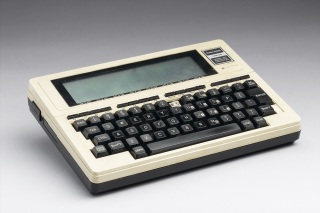
Getty Images
Osborne hit that price point by using off-the-shelf parts. Grid, however, packed the Compass’s magnesium case with cutting-edge technologies and priced its computer at a daunting $8150, or around $19,000 in current dollars. Instead of a bulky CRT display, the machine had a 6″ active-matrix electro-luminescent flat-panel screen. And instead of a floppy-disk drive, it used 384KB of bubble memory for storage.
At the time, many folks thought that both technologies were the wave of the future, but neither one saw widespread use in later portable computers. What stuck was industrial designer William Moggridge’s case, with its flip-up screen. (Moggridge had settled on it after Grid abandoned earlier, more Dynabook-like concepts.)
Moggridge’s design made for a far more portable computer than the Osborne. It let the user angle the screen to his or her preference. The backside of the display protected both the screen and the keyboard when the machine wasn’t in use. And unlike numerous mobile-computer cases to come, it was mechanically simple. It’s one of the most clever pieces of engineering in computing history.
While the Compass originated the clamshell design and is instantly identifiable as an ancestor of all modern laptops, this first stab at the concept did vary from later versions in some respects. Its hinge wasn’t in the back, as in all modern clamshells, but in the middle of the case; that worked because the 6″ screen was so small. The case also incorporated a fold-out leg which raised the back of the machine, angling the keyboard for comfy typing and discouraging overheating.
The Compass was almost 2″ thick, or about 18 times thicker than the thinnest part of Apple’s MacBook Air. In 1982, that looked remarkably trim: The Osborne 1 was 8.5″ tall and couldn’t be stowed underneath an airplane seat or stored in a piece of luggage.
Today, the term “laptop” is synonymous with “notebook,” and in both instances, it’s assumed that they reference a computing device with a clamshell case. That wasn’t always so. In fact, when Grid announced its computer, nobody called it a “laptop.” That term was apparently first applied to the Gavilan SC, another early example which was unveiled a year later and available only briefly before its maker went bankrupt.
Both the Grid and the Gavilan were bulky by modern standards; in the early days, a laptop wasn’t necessarily a computer which you could slip in a briefcase or tuck effortlessly under your arm. The first popular notebook–basically, a compact laptop–was the TRS-80 Model 100, which Radio Shack released in 1983. It wasn’t a clamshell, though: The skinny LCD display sat above the keyboard.
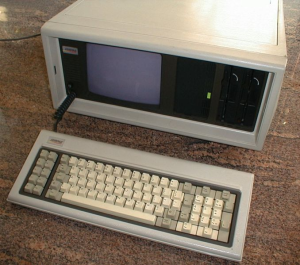
Wikipedia
Also popular, and even further afield from Grid’s clamshell design, was the Compaq Portable, announced in November of 1982. It sported an Osborne-like luggable case, and for several years, businesspeople did indeed lug them everywhere.
It was only in the mid-to-late 1980s when it was clear that clamshell laptops inspired by Grid’s Compass would be the primary form of portable computing device. IBM PC-compatible models such as Toshiba’s T1100 were bestsellers, and unlike the Compass, they ran off batteries, making them far more mobile.
In 1988, consumer-electronics behemoth Radio Shack bought Grid Systems. The inventor of the laptop never became huge, but it was still doing innovative things such as creating the GridPad, one of the first tablets. The patent that Grid had received for the Compass’s case was still in effect, so Radio Shack was able to collect licensing fees from Toshiba and other makers of clamshell portables.
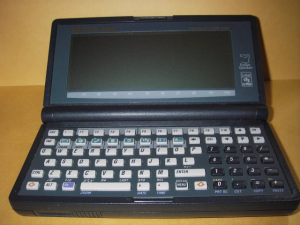
Wikipedia
By the late 1980s and early 1990s, the clamshell case was so familiar that it was used, in downsized form, for early “palmtop” pocket-sized computers such as the Atari Portfolio, Poqet and HP 95LX. It was only when Apple unveiled its Newton PDA in 1992 that it became accepted wisdom that a miniature computer should be anything but a Compass-like laptop, only smaller.
(MORE: Newton, Reconsidered)
For full-sized portable PCs, the clamshell proved remarkably impervious to improvement. Almost all the change to Grid’s original concept has been evolutionary: thinner cases, bigger screens, faster components, additional features crammed inside.
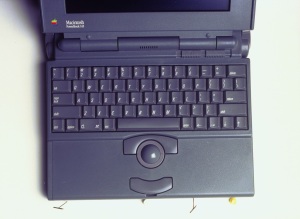
Getty Images
The last basic change came a couple of decades ago when–after a brief period of ungainly clip-on trackballs–industrial designers started accommodating built-in pointing devices.
After experimenting with trackballs, pointing sticks and even J keys you could wiggle in different directions, most companies settled on trackpads, a design first seen in Apple’s 1994 PowerBook 500 and still standard today.
It’s not that nobody tried to profoundly revamp the laptop. Many did, just not successfully.


